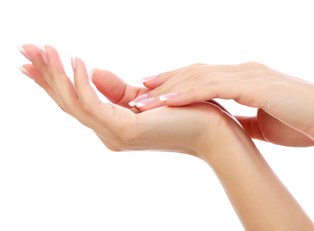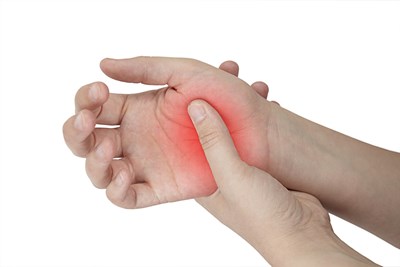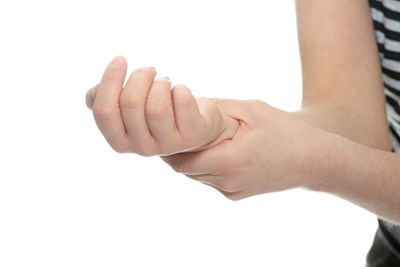Continual hand pain can be a hindrance to our work and daily activities. Swelling and decreased range of motion may accompany hand pain. Arthritis, an affliction of one or more joints is a common cause. Osteoarthritis is caused by normal exhaustion of a joint over time. Rheumatoid arthritis is a disease that tricks our own immune system to produce antibodies that attack the joint's cartilage. Tissue in and around the joint can become reddened and swollen. Another cause of hand pain is tenosynovitis, a swelling of the lubricating sleeve around a tendon.
What Commonly Causes Hand Pain?
The affected tendon is painful, swollen and difficult to move. The condition can cause the finger to "stick" in a flexed position, "stenosing" tenosynovitis. Hand pain and swelling at the base of the thumb may be symptoms of de Quervain's tenosynovitis. The two major tendons used for hand movement lie together at the base of the thumb, normally sliding through the tunnel that links them to the bottom of the thumb. In de Quervain's tendon movement is limited by sheath swelling. The pain can occur suddenly and increase with time. Untreated, pain spreads into the thumb, back into the forearm or both. Using the thumb to pinch or grasp increases the pain. A sensation of something "sticking" may be noted with thumb movement. You may hear a squeaking sound because the tendon sheaths are swollen. De Quervain's tenosynovitis is commonly caused by over use of the wrist, restrictive scar tissue formed after injury and rheumatoid arthritis. Rheumatoid arthritis causes hand pain, swollen and tender joints, red and puffy hands. Morning stiffness and fatigue may accompany rheumatoid arthritis. The disease affects the smaller joints first, affecting the same joints on both sides of the body
NSAIDs
Hand pain relief for mild tenosynovitis is treated with non-steroidal, anti-inflammatory drugs (NSAID) such as Naproxen, ibuprofen or diclofenac. It's very important, for hand pain relief to give the tendons rest, wearing a brace helps. Cortisone injections followed by a regimen of paracetamol and ibuprofen are indicated for more severe cases. The cause of de Quervain's tenosynovitis is unknown. If you have wrist or hand pain that increases with repeated wrist and hand movements, minimize heavy grasping, wringing or twisting motions and pinching. Hand pain relief for de Quervain's tenosynovitis starts with splinting the wrist continuously for four to six weeks and applying ice as needed to relieve swelling.
Steroids
Hand pain relief may be obtained by injecting the area with steroids. An outpatient surgical procedure can be performed to release the tendon sheath thereby taking away the friction and letting the tendon slide smoothly again. Your physician may order physical or occupational therapy afterwards for strength recovery. Hand pain relief for rheumatoid arthritis is best treated aggressively with medication, exercise, physical therapy and on occasion surgery.
Blockers and Other Medications
Non steroidal anti-inflammatory drugs provide hand pain relief and reduce inflammation. Disease modifying anti-rheumatic drugs like methotrexate slow or stop the progress of rheumatoid arthritis. Genetically engineered proteins or biologics block parts of the immune system that cause swelling. Blockers such as Enbrel combined with methotrexate give hand pain relief and lessen joint damage. When rheumatoid arthritis is severe steroids may be called on for hand pain relief. Steroid use can be short or long term depending on disease severity. Physical and occupational therapy is more than exercise. It's a plan for daily living, using heat and ice, therapeutic massage, performing tasks with less stress and staying motivated. All medications have side effects that need to be discussed with your doctor. Sometimes a medication's benefits out weigh the side effects as long as precautions are observed.




